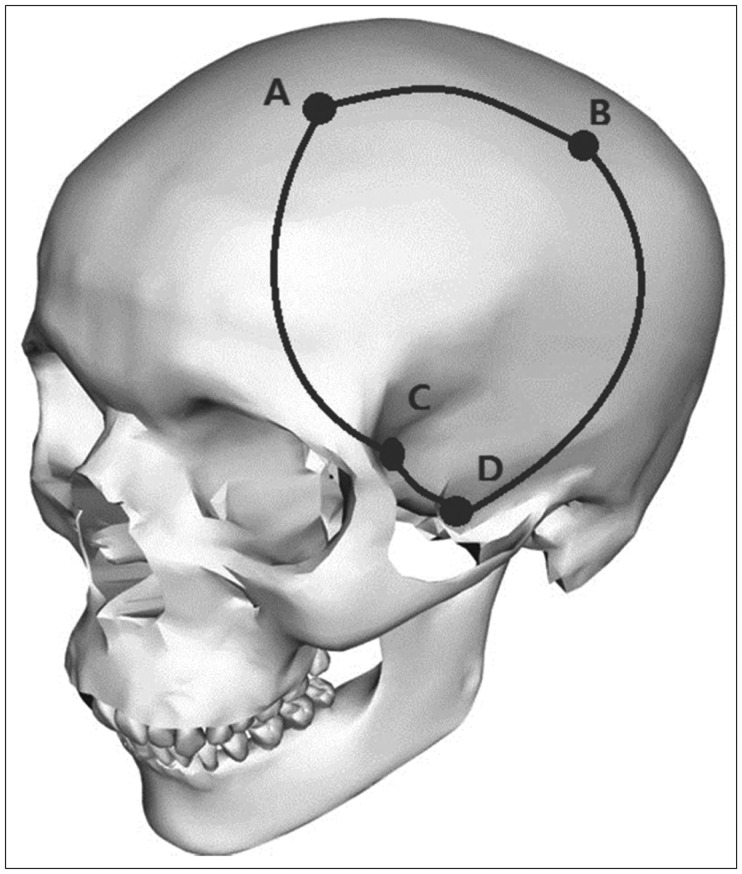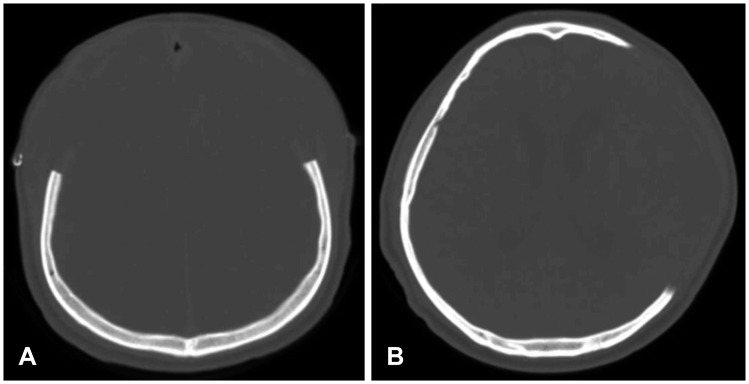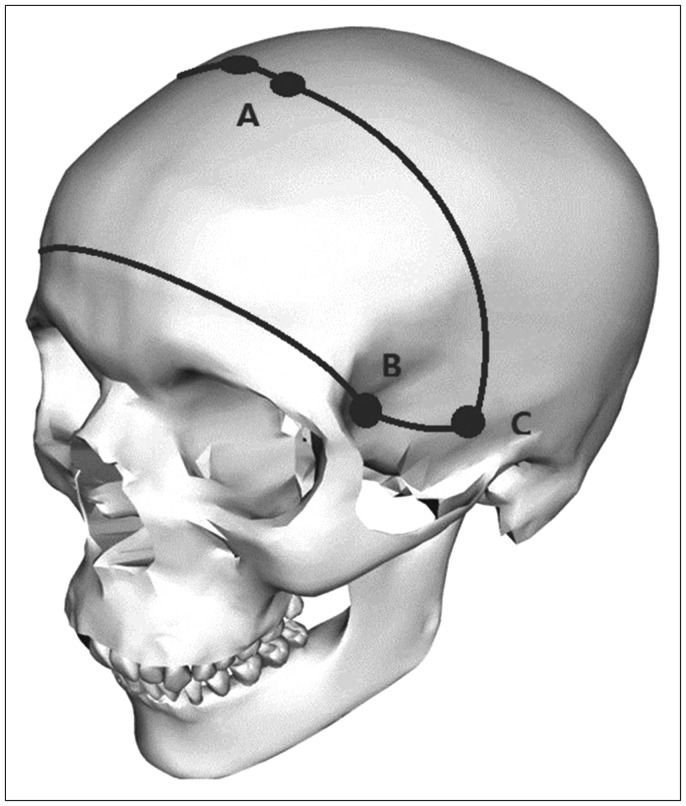1. Aarabi B, Hesdorffer DC, Ahn ES, Aresco C, Scalea TM, Eisenberg HM. Outcome following decompressive craniectomy for malignant swelling due to severe head injury. J Neurosurg. 2006; 104:469–479. PMID:
16619648.

2. Alvis-Miranda H, Castellar-Leones SM, Moscote-Salazar LR. Decompressive craniectomy and traumatic brain injury: a review. Bull Emerg Trauma. 2013; 1:60–68. PMID:
27162826.
3. Appelboom G, Piazza M, Zoller SD, Connolly ES Jr. Clinical trials in decompressive craniectomy after severe diffuse traumatic brain injury. World Neurosurg. 2013; 80:e153–e155. PMID:
22120384.

4. Bratton SL, Chestnut RM, Ghajar J, McConnell Hammond FF, Harris OA, Hartl R, et al. Guidelines for the management of severe traumatic brain injury. VI. Indications for intracranial pressure monitoring. J Neurotrauma. 2007; 24(Suppl 1):S37–S44. PMID:
17511544.
5. Bratton SL, Chestnut RM, Ghajar J, McConnell Hammond FF, Harris OA, Hartl R, et al. Guidelines for the management of severe traumatic brain injury. VIII. Intracranial pressure thresholds. J Neurotrauma. 2007; 24(Suppl 1):S55–S58. PMID:
17511546.
6. Chesnut RM, Temkin N, Carney N, Dikmen S, Rondina C, Videtta W, et al. A trial of intracranial-pressure monitoring in traumatic brain injury. N Engl J Med. 2012; 367:2471–2481. PMID:
23234472.

7. Clifton GL, Miller ER, Choi SC, Levin HS. Fluid thresholds and outcome from severe brain injury. Crit Care Med. 2002; 30:739–745. PMID:
11940738.

8. Clower WT, Finger S. Discovering trepanation: the contribution of Paul Broca. Neurosurgery. 2001; 49:1417–1425. PMID:
11846942.

9. Cooper DJ, Rosenfeld JV, Murray L, Arabi YM, Davies AR, D'Urso P, et al. Decompressive craniectomy in diffuse traumatic brain injury. N Engl J Med. 2011; 364:1493–1502. PMID:
21434843.

10. Cooper PR, Hagler H, Clark WK, Barnett P. Enhancement of experimental cerebral edema after decompressive craniectomy: implications for the management of severe head injuries. Neurosurgery. 1979; 4:296–300. PMID:
450227.
11. Cooper PR, Rovit RL, Ransohoff J. Hemicraniectomy in the treatment of acute subdural hematoma: a re-appraisal. Surg Neurol. 1976; 5:25–28. PMID:
1265621.
12. Cremer OL, Slooter AJ. Craniectomy in diffuse traumatic brain injury. N Engl J Med. 2011; 365:375.

13. Cushing H. The establishment of cerebral hernia as a decompressive measure for inaccessible brain tumors: with the description of intramuscular methods of making the bone defect in temporal and occipital regions. Surg Gynecol Obstet. 1905; 1:297–314.
14. El Gindi S. Neurosurgery in Egypt: past, present, and future-from pyramids to radiosurgery. Neurosurgery. 2002; 51:789–795. PMID:
12188959.

15. Gaab MR, Rittierodt M, Lorenz M, Heissler HE. Traumatic brain swelling and operative decompression: a prospective investigation. Acta Neurochir Suppl (Wien). 1990; 51:326–328. PMID:
2089928.

16. Gerl A, Tavan S. Bilateral craniectomy in the treatment of severe traumatic brain edema. Zentralbl Neurochir. 1980; 41:125–138. PMID:
7435005.
17. Ghajar J. Traumatic brain injury. Lancet. 2000; 356:923–929. PMID:
11036909.

18. Goodman MD, Makley AT, Lentsch AB, Barnes SL, Dorlac GR, Dorlac WC, et al. Traumatic brain injury and aeromedical evacuation: when is the brain fit to fly? J Surg Res. 2010; 164:286–293. PMID:
20006349.

19. Gopinath SP, Robertson CS, Contant CF, Hayes C, Feldman Z, Narayan RK, et al. Jugular venous desaturation and outcome after head injury. J Neurol Neurosurg Psychiatry. 1994; 57:717–723. PMID:
8006653.

20. Hofmeijer J, Kappelle LJ, Algra A, Amelink GJ, van Gijn J, van der Worp HB. Surgical decompression for space-occupying cerebral infarction (the Hemicraniectomy After Middle Cerebral Artery infarction with Life-threatening Edema Trial [HAMLET]): a multicentre, open, randomised trial. Lancet Neurol. 2009; 8:326–333. PMID:
19269254.

21. Honeybul S, Ho KM, Lind CR. What can be learned from the DECRA study. World Neurosurg. 2013; 79:159–161. PMID:
23022646.

22. Honeybul S, Ho KM, Lind CR, Gillett GR. The future of decompressive craniectomy for diffuse traumatic brain injury. J Neurotrauma. 2011; 28:2199–2200. PMID:
22003825.

23. Hutchinson PJ, Kolias AG, Timofeev IS, Corteen EA, Czosnyka M, Timothy J, et al. Trial of decompressive craniectomy for traumatic intracranial hypertension. N Engl J Med. 2016; 375:1119–1130. PMID:
27602507.

24. Jamieson KG, Yelland JD. Extradural hematoma. Report of 167 cases. J Neurosurg. 1968; 29:13–23. PMID:
5302643.
25. Jamieson KG, Yelland JD. Surgically treated traumatic subdural hematomas. J Neurosurg. 1972; 37:137–149. PMID:
5046082.

26. Jamieson KG, Yelland JD. Traumatic intracerebral hematoma. Report of 63 surgically treated cases. J Neurosurg. 1972; 37:528–532. PMID:
5076369.
27. Jiang JY, Xu W, Li WP, Xu WH, Zhang J, Bao YH, et al. Efficacy of standard trauma craniectomy for refractory intracranial hypertension with severe traumatic brain injury: a multicenter, prospective, randomized controlled study. J Neurotrauma. 2005; 22:623–628. PMID:
15941372.

28. Jüttler E, Schwab S, Schmiedek P, Unterberg A, Hennerici M, Woitzik J, et al. Decompressive surgery for the treatment of malignant infarction of the middle cerebral artery (DESTINY): a randomized, controlled trial. Stroke. 2007; 38:2518–2525. PMID:
17690310.
29. Kakar V, Nagaria J, John Kirkpatrick P. The current status of decompressive craniectomy. Br J Neurosurg. 2009; 23:147–157. PMID:
19306169.

30. Kan EM, Ling EA, Lu J. Microenvironment changes in mild traumatic brain injury. Brain Res Bull. 2012; 87:359–372. PMID:
22289840.

31. Kellie G. An account of the appearances observed in the dissection of two or three individuals presumed to have perished in the storm of the 3rd, and whose bodies were discovered in the vicinity of Leith on the morning of the 4th, November 1821 with some reflections on the pathology of the brain. Trans Edinb Med Chir Soc. 1824; 1:84–169.
32. Kjellberg RN, Prieto A Jr. Bifrontal decompressive craniotomy for massive cerebral edema. J Neurosurg. 1971; 34:488–493. PMID:
5554353.

33. Kocher T. Hirnerschütterung, hirndruck und chirurgische eingriffe bei hirnkrankheiten. Wien, AT: Alfred Holder;1901.
34. Kolias AG, Kirkpatrick PJ, Hutchinson PJ. Decompressive craniectomy: past, present and future. Nat Rev Neurol. 2013; 9:405–415. PMID:
23752906.

35. Kramer AH, Deis N, Ruddell S, Couillard P, Zygun DA, Doig CJ, et al. Decompressive craniectomy in patients with traumatic brain injury: are the usual indications congruent with those evaluated in clinical trials? Neurocrit Care. 2016; 25:10–19. PMID:
26732269.

36. Langlois JA, Rutland-Brown W, Wald MM. The epidemiology and impact of traumatic brain injury: a brief overview. J Head Trauma Rehabil. 2006; 21:375–378. PMID:
16983222.
37. Li X, von Holst H, Kleiven S. Decompressive craniectomy causes a significant strain increase in axonal fiber tracts. J Clin Neurosci. 2013; 20:509–513. PMID:
23403173.

38. Martin G. Was Hippocrates a beginner at trepanning and where did he learn? J Clin Neurosci. 2000; 7:500–502. PMID:
11029229.

39. Mendelow AD, Gregson BA, Rowan EN, Francis R, McColl E, McNamee P, et al. Early surgery versus initial conservative treatment in patients with traumatic intracerebral hemorrhage (STITCH [Trauma]): the first randomized trial. J Neurotrauma. 2015; 32:1312–1323. PMID:
25738794.
40. Monro A. Observations on the structure and functions of the nervous system. Edinburgh, UK: William Creech, Joseph Johnson;1783.
41. Nordström CH, Reinstrup P, Xu W, Gärdenfors A, Ungerstedt U. Assessment of the lower limit for cerebral perfusion pressure in severe head injuries by bedside monitoring of regional energy metabolism. Anesthesiology. 2003; 98:809–814. PMID:
12657839.

42. Pereira WC, Neves VJ, Rodrigues Y. Bifrontal decompressive craniotomy as the treatment for severe cerebral edema. Arq Neuropsiquiatr. 1977; 35:99–111. PMID:
869742.
43. Quinn TM, Taylor JJ, Magarik JA, Vought E, Kindy MS, Ellegala DB. Decompressive craniectomy: technical note. Acta Neurol Scand. 2011; 123:239–244. PMID:
20637010.

44. Ransohoff J, Benjamin V. Hemicraniectomy in the treatment of acute subdural haematoma. J Neurol Neurosurg Psychiatry. 1971; 34:106.

45. Santana-Cabrera L, Pérez-Acosta G, Rodríguez-Escot C, Lorenzo-Torrent R, Sánchez-Palacios M. Complications of post-injury decompressive craniectomy. Int J Crit Illn Inj Sci. 2012; 2:186–188. PMID:
23181215.

46. Servadei F. Clinical value of decompressive craniectomy. N Engl J Med. 2011; 364:1558–1559. PMID:
21434844.

47. Stocchetti N, Maas AI. Traumatic intracranial hypertension. N Engl J Med. 2014; 370:2121–2130. PMID:
24869722.

48. Tagliaferri F, Zani G, Iaccarino C, Ferro S, Ridolfi L, Basaglia N, et al. Decompressive craniectomies, facts and fiction: a retrospective analysis of 526 cases. Acta Neurochir (Wien). 2012; 154:919–926. PMID:
22402877.

49. Taylor A, Butt W, Rosenfeld J, Shann F, Ditchfield M, Lewis E, et al. A randomized trial of very early decompressive craniectomy in children with traumatic brain injury and sustained intracranial hypertension. Childs Nerv Syst. 2001; 17:154–162. PMID:
11305769.

50. Timmons SD, Ullman JS, Eisenberg HM. Craniectomy in diffuse traumatic brain injury. N Engl J Med. 2011; 365:373.

51. Vahedi K, Hofmeijer J, Juettler E, Vicaut E, George B, Algra A, et al. Early decompressive surgery in malignant infarction of the middle cerebral artery: a pooled analysis of three randomised controlled trials. Lancet Neurol. 2007; 6:215–222. PMID:
17303527.

52. Venes JL, Collins WF. Bifrontal decompressive craniectomy in the management of head trauma. J Neurosurg. 1975; 42:429–433. PMID:
1123660.

53. von Holst H, Li X, Kleiven S. Increased strain levels and water content in brain tissue after decompressive craniotomy. Acta Neurochir (Wien). 2012; 154:1583–1593. PMID:
22648479.
54. Wilson MH. Monro-Kellie 2.0: The dynamic vascular and venous pathophysiological components of intracranial pressure. J Cereb Blood Flow Metab. 2016; 36:1338–1350. PMID:
27174995.

55. Yang XF, Wen L, Shen F, Li G, Lou R, Liu WG, et al. Surgical complications secondary to decompressive craniectomy in patients with a head injury: a series of 108 consecutive cases. Acta Neurochir (Wien). 2008; 150:1241–1247. PMID:
19005615.

56. Yu SH, Kim BC, Choi JY, Lee JI, Cho WH, Choi HJ. Addition of resection of temporal muscle and fascia in decompressive craniectomy in the treatment of traumatic brain injury. Korean J Neurotrauma. 2016; 12:84–88. PMID:
27857913.







 PDF
PDF ePub
ePub Citation
Citation Print
Print




 XML Download
XML Download